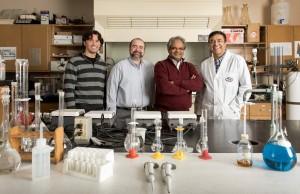 It’s often said that good things come in small packages. One team of UALR researchers will put this statement to the test as they explore the power of nanocarbons—tiny, incredibly strong materials—to change the world.
It’s often said that good things come in small packages. One team of UALR researchers will put this statement to the test as they explore the power of nanocarbons—tiny, incredibly strong materials—to change the world.
Supported by a $50,000 ORSP seed grant, the team will research the ability of modified nanocarbons to purify water, generate and store energy, and attack bacteria. Dr. Tito Viswanathan, Professor of Chemistry, will lead the project. Dr. Brian Berry, Associate Professor of Chemistry; Dr. Nawab Ali, Associate Professor of Biology; and Dr. Allan Thomas, Assistant Professor of Physics and Astronomy, join him as co-principal investigators.
The team will convert lignin and tannin, which are plant-based, abundant, renewable resources, into “doped” nanocarbon, using an innovative, cost-effective process that Dr. Viswanathan designed himself. When carbon nanomaterials are doped, chemical elements replace some of the carbon atoms, changing the material’s structure and giving it unusual traits. These changes “are actually defects in the carbon structure,” Dr. Viswanathan said, “and these defects lead to some exciting properties, including high electrical conductivity.”
With these microscopic modified materials, the researchers hope to alleviate some of our world’s most critical problems. The need for safe, sustainable, and affordable food, energy, and water is both urgent and globally recognized. Indeed, the National Science Foundation is investing millions of dollars in research projects that offer innovative approaches to addressing it.
The UALR project has the potential to meet all these global needs at once—without draining the earth’s resources. “Most of the [current] resources that we rely on for our existence are nonrenewable resource-based. So, if you’re dependent on those nonrenewable resources, you cannot have a sustainable civilization,” Dr. Viswanathan said. “The project theoretically involves all aspects of sustainability.”
While nanocarbon research is relatively common today, this project stands out. According to Dr. Viswanathan, other researchers working with doped nanocarbons tend to use nonrenewable resources and expensive, time-consuming methods. In contrast, the UALR team’s process is efficient and sustainable at every step—from the source of the nanocarbons to the method used to prepare them to their practical applications once they’re doped.
In addition, doped nanocarbons with multi-functional, real-world applications in food, water, and energy are rare. Dr. Viswanathan and his team are some of the only researchers exploring this blended area, and they know just how unique—and exciting—the project is. “We’re using renewable resources, very little investment, producing these nanocarbons with amazing properties, and which can solve a whole lot of problems.”
Not only does the research have the potential to improve the world, but the researchers are making sure that the next generation has this potential as well. Each participating scientist will supervise a UALR undergraduate student, training him or her in research practices and lab work. The researchers will intentionally seek out students from underrepresented groups, giving them hands-on preparation for a career in science that they might not otherwise have access to.
The team knows first-hand the importance of giving students practical research experience. Over a decade ago, Dr. Berry worked under Dr. Viswanathan as a graduate student. Today, the two have authored multiple publications together, and Dr. Berry is the coordinator for the Applied Science graduate program.
Dr. Berry’s expertise in chemistry, as well as Dr. Ali’s in biology and Dr. Thomas’s in physics, is essential to the research plan. Dr. Viswanathan asserts that the project couldn’t exist without the co-PIs’ involvement. “This is a project that one person cannot do alone, because it’s so branched out, and we need everybody’s expertise and input to make it a success.”
To the researchers, “success” would mean patentable, highly useful products that benefit humanity. And with grant funding, compelling preliminary data, and brilliant student and faculty researchers on their side, meeting this ambitious goal could be just a few years away.